Texture types
You can import different Texture types into the Unity Editor via the Texture Importer.
Below are the properties available to configure the various Texture types in Unity in the Texture Inspector window. Scroll down or select from the list below to find details of the Texture type you wish to learn about.
- Texture types
- Default
- Normal map
- Editor GUI and Legacy GUI
- Sprite (2D and UI)
- Cursor
- Cookie
- Lightmap
- Single Channel
Default
Default is the most common Texture type used for all Textures. It provides access to most of the properties for Texture importing. With this Texture type, you can also change the Texture Shape property to define the Texture Shape.
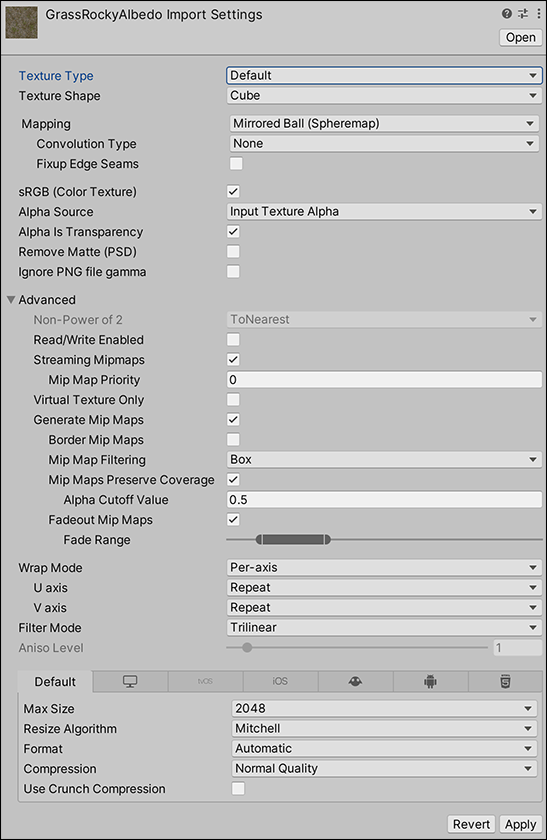
When you choose the Default Texture type, the following properties are available (click the links for detailed information on each property):
| Property: | Function: |
|---|---|
| sRGB (Color Texture) | Enable this property to specify that the Texture is stored in gamma space. More info. |
| Alpha Source | Specify how the alpha channel of the Texture is generated. More info. |
| Alpha is Transparency | Enable this property to dilate the color and avoid filtering artifacts on the edges if the alpha channel you specify is Transparency. More info. |
| Remove Matte (PSD) | Enable special processing for Photoshop files that use transparency (blending color pixels with white). More info |
| Ignore PNG file gamma | Enable this property to ignore the Gamma attribute in PNG files. More info. |
| Non Power of 2 | If the Texture has a non-power of two (NPOT) dimension size, this defines a scaling behavior at import time. More info. |
| Read/Write Enabled | Enable this to access the Texture data from scripts using Texture2D.SetPixels, Texture2D.GetPixels and other Texture2D methods. More info. |
| Virtual Texture Only | Enable this texture to use it solely in combination with a Texture Stack for Virtual Texturing. More info. |
| Streaming Mip Maps | Enable this checkbox to use Mip Map Streaming on this Texture. More info. |
| Generate Mip Maps | Check this box to enable mipmap generation. More info. This property is enabled by default. |
| Wrap Mode | Select how the Texture behaves when tiled. More info. |
| Filter Mode | Select how the Texture is filtered when it gets stretched by 3D transformations. More info. |
| Aniso Level | Increases Texture quality when viewing the Texture at a steep angle. More info. |
In addition, you can use the Platform-specific overrides panel to set default options and their overrides for a specific platforms.
Normal map
Select Normal map to turn the color channels into a format suitable for real-time normal mapping. With this Texture type, you can also change the Texture Shape property to define the Texture Shape.

When you choose the Normal map Texture type, you can set the following additional properties:
| Property: | Function: | |
|---|---|---|
| Create from Grayscale | Enable this property to create the Normal Map from a grayscale heightmap. When enabled, the Bumpiness and Filtering options become available. This option is disabled by default. | |
| Bumpiness | Control the amount of bumpiness. A low bumpiness value means that even sharp contrast in the heightmap is translated to gentle angles and bumps. A high value creates exaggerated bumps and very high-contrast lighting responses to the bumps. This option is only visible if Create from Grayscale is checked. | |
| Filtering | Determine how the bumpiness is calculated: - Smooth generates Normal Maps with standard (forward differences) algorithms. - Sharp generates Normal Maps that are sharper than Standard. This is also known as a Sobel filter. |
|
| Ignore PNG file gamma | Enable this property to ignore the Gamma attribute in PNG files. More info. | |
| Non Power of 2 | If the Texture has a non-power of two (NPOT) dimension size, this defines a scaling behavior at import time. More info. | |
| Read/Write Enabled | Enable this to access the Texture data from scripts using Texture2D.SetPixels, Texture2D.GetPixels and other Texture2D methods. More info. | |
| Virtual Texture Only | Enable this texture to use it solely in combination with a Texture Stack for Virtual Texturing. More info. | |
| Streaming Mip Maps | Enable this checkbox to use Mip Map Streaming on this Texture. More info. | |
| Generate Mip Maps | Check this box to enable mipmap generation. More info. This property is enabled by default. |
|
| Wrap Mode | Select how the Texture behaves when tiled. More info. | |
| Filter Mode | Select how the Texture is filtered when it gets stretched by 3D transformations. More info. | |
| Aniso Level | Increases Texture quality when viewing the Texture at a steep angle. More info. | |
In addition, you can use the Platform-specific overrides panel to set default options and their overrides for a specific platforms.
Editor GUI and Legacy GUI
Select Editor GUI and Legacy GUI if you are using the Texture on any HUD or GUI controls. With this Texture type, the Texture Shape property is always set to 2D for this Texture Type. For more information, see the documentation on Texture Shapes.
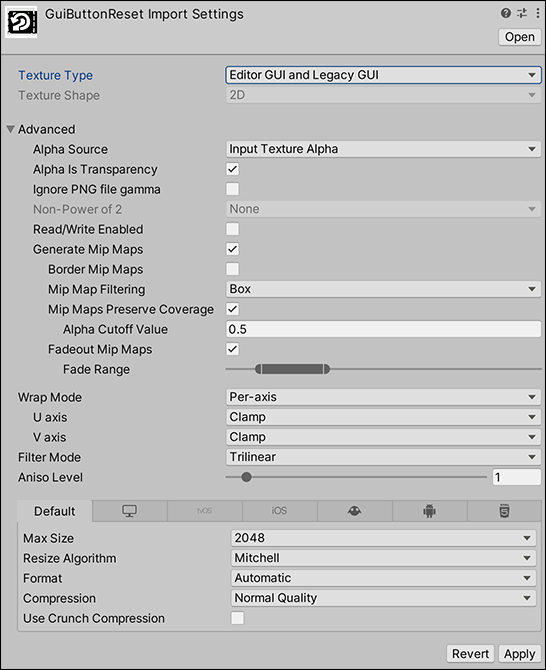
When you choose the Editor GUI and Legacy GUI Texture type, you can set the following additional properties:
| Property: | Function: |
|---|---|
| Alpha Source | Specify how the alpha channel of the Texture is generated. More info. |
| Alpha is Transparency | Enable this property to dilate the color and avoid filtering artifacts on the edges if the alpha channel you specify is Transparency. More info. |
| Remove Matte (PSD) | Enable special processing for Photoshop files that use transparency (blending color pixels with white). More info |
| Ignore PNG file gamma | Enable this property to ignore the Gamma attribute in PNG files. More info. |
| Non Power of 2 | If the Texture has a non-power of two (NPOT) dimension size, this defines a scaling behavior at import time. More info. |
| Read/Write Enabled | Enable this to access the Texture data from scripts using Texture2D.SetPixels, Texture2D.GetPixels and other Texture2D methods. More info. |
| Generate Mip Maps | Check this box to enable mipmap generation. More info. This property is disabled by default. |
| Wrap Mode | Select how the Texture behaves when tiled. More info. |
| Filter Mode | Select how the Texture is filtered when it gets stretched by 3D transformations. More info. |
| Aniso Level | Increases Texture quality when viewing the Texture at a steep angle. More info. |
In addition, you can use the Platform-specific overrides panel to set default options and their overrides for a specific platforms.
Sprite (2D and UI)
Select Sprite (2D and UI) if you are using the Texture in a 2D game as a Sprite. With this Texture type, the Texture Shape property is always set to 2D for this Texture Type. For more information, see the documentation on Texture Shapes.
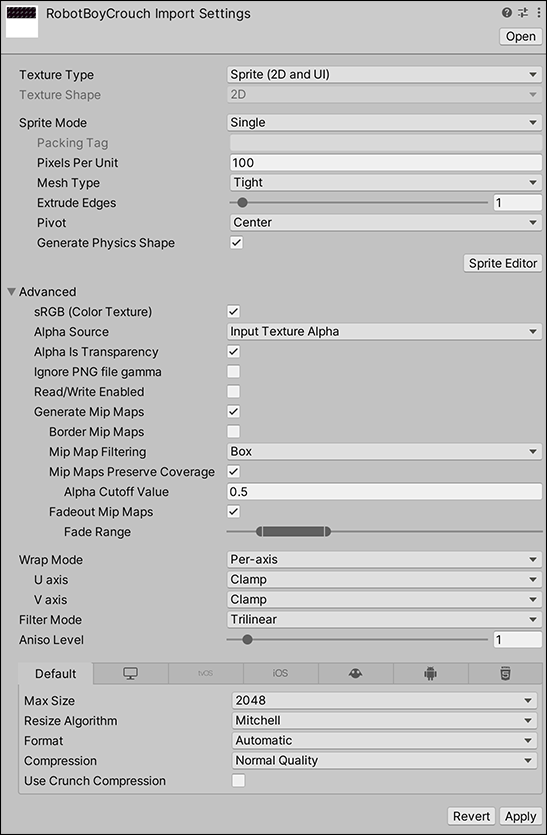
When you choose the Sprite (2D and UI) Texture type, you can set the following additional properties:
| Property: | Function: | |
|---|---|---|
| Sprite Mode | Specify how to extract the Sprite graphic from the image. The default for this option is Single. | |
| Single | Use the Sprite image as is. You can clip and edit the image in the Sprite Editor to refine it further, but Unity treats the Sprite generated from the imported Texture as a single Asset. | |
| Multiple | Choose this value if your image has several elements in the same image. You can then define the location of the elements in the Sprite Editor so that Unity knows how to split the image into different sub-Assets. For example, you can create animation frames from a single sheet with multiple poses, create Tiles from a single Tilesheet, or create the different parts of a character. | |
| Polygon | Choose this value to clip the Sprite Texture according to the Mesh defined in the Sprite Editor’s Sprite Custom Outline. | |
| Packing Tag | Specify (by name) the Sprite Atlas which you want to pack this Texture into. This property is visible only when you enable the Legacy Sprite Packer in your Project. | |
| Pixels Per Unit | The number of pixels of width/height in the Sprite image that correspond to one distance unit in world space. | |
| Mesh Type | Define the Mesh type for the Sprite you want Unity to generate. The default for this option is Tight. Note: This property is only available for the Single and Multiple Sprite Modes. |
|
| Full Rect | Choose this value to create a quad (four-sided polygon) to map the Sprite onto. | |
| Tight | Choose this value to generate a Mesh based on pixel alpha value. The Mesh that Unity generates generally follows the shape of the Sprite. Note: Any Sprite that is smaller than 32x32 uses Full Rect, even when Tight is specified. |
|
| Extrude Edges | Use the slider to determine how much area to leave around the Sprite in the generated Mesh. | |
| Pivot | The location in the image where the Sprite’s local coordinate system originates. Choose one of the pre-set options, or select Custom to set your own Pivot location in X and Y. Note: This property is only available for the Single Sprite Mode. |
|
| Generate Physics Shape | When this is enabled and you have not defined a Custom Physics Shape for this Sprite, Unity generates a default Physics Shape from the outline of the Sprite. Note: This property is only available for the Single and Multiple Sprite Modes. |
|
| Sprite Editor | Click this button to define how you want Unity to separate the elements on an image with Multiple elements (to create sub-Assets) or refine the shape, size, and pivot position of a Polygon shape. Note: You need to install the 2D Sprite package in order to use the Sprite Editor. For information about how to find and install packages in the Unity Package Manager, see Finding packages and Installing from the registry. |
|
| sRGB (Color Texture) | Enable this property to specify that the Texture is stored in gamma space. More info. | |
| Alpha Source | Specify how the alpha channel of the Texture is generated. More info. | |
| Alpha is Transparency | Enable this property to dilate the color and avoid filtering artifacts on the edges if the alpha channel you specify is Transparency. More info. | |
| Remove Matte (PSD) | Enable special processing for Photoshop files that use transparency (blending color pixels with white). More info | |
| Ignore PNG file gamma | Enable this property to ignore the Gamma attribute in PNG files. More info. | |
| Read/Write Enabled | Enable this to access the Texture data from scripts using Texture2D.SetPixels, Texture2D.GetPixels and other Texture2D methods. More info. | |
| Generate Mip Maps | Check this box to enable mipmap generation. More info. This property is disabled by default. |
|
| Wrap Mode | Select how the Texture behaves when tiled. More info. | |
| Filter Mode | Select how the Texture is filtered when it gets stretched by 3D transformations. More info. | |
| Aniso Level | Increases Texture quality when viewing the Texture at a steep angle. More info. | |
In addition, you can use the Platform-specific overrides panel to set default options and their overrides for a specific platforms.
Cursor
Select Cursor to use the Texture as a custom cursor. With this Texture type, the Texture Shape property is always set to 2D for this Texture Type. For more information, see the documentation on Texture Shapes.
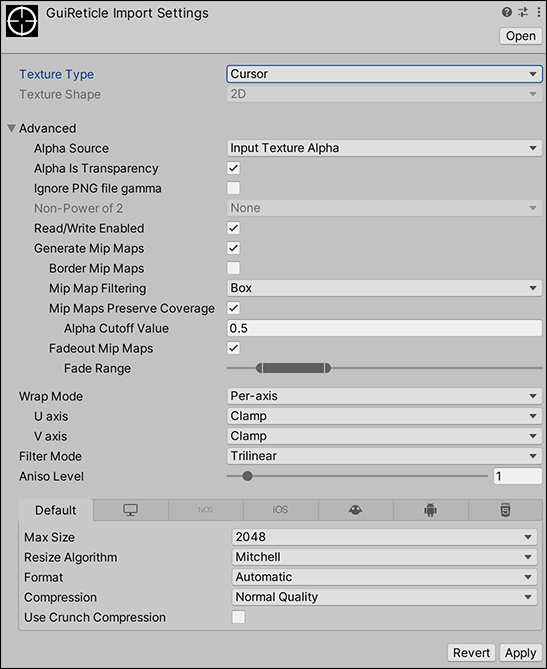
When you choose the Cursor Texture type, you can set the following additional properties:
| Property: | Function: |
|---|---|
| Alpha Source | Specify how the alpha channel of the Texture is generated. More info. |
| Alpha is Transparency | Enable this property to dilate the color and avoid filtering artifacts on the edges if the alpha channel you specify is Transparency. More info. |
| Remove Matte (PSD) | Enable special processing for Photoshop files that use transparency (blending color pixels with white). More info |
| Ignore PNG file gamma | Enable this property to ignore the Gamma attribute in PNG files. More info. |
| Non Power of 2 | If the Texture has a non-power of two (NPOT) dimension size, this defines a scaling behavior at import time. More info. |
| Read/Write Enabled | Enable this to access the Texture data from scripts using Texture2D.SetPixels, Texture2D.GetPixels and other Texture2D methods. More info. |
| Generate Mip Maps | Check this box to enable mipmap generation. More info. This property is disabled by default. |
| Wrap Mode | Select how the Texture behaves when tiled. More info. |
| Filter Mode | Select how the Texture is filtered when it gets stretched by 3D transformations. More info. |
| Aniso Level | Increases Texture quality when viewing the Texture at a steep angle. More info. |
In addition, you can use the Platform-specific overrides panel to set default options and their overrides for a specific platforms.
Cookie
Select Cookie to set your Texture up with the basic parameters used for cookies in the Built-in Render Pipeline. With this Texture type, Unity updates the Texture Shapes property automatically based on the selected Light Type:
- Directional and Spotlight cookies are always 2D Textures (the 2D shape type).
- Point Light cookies must be cubemaps (the Cube shape type).
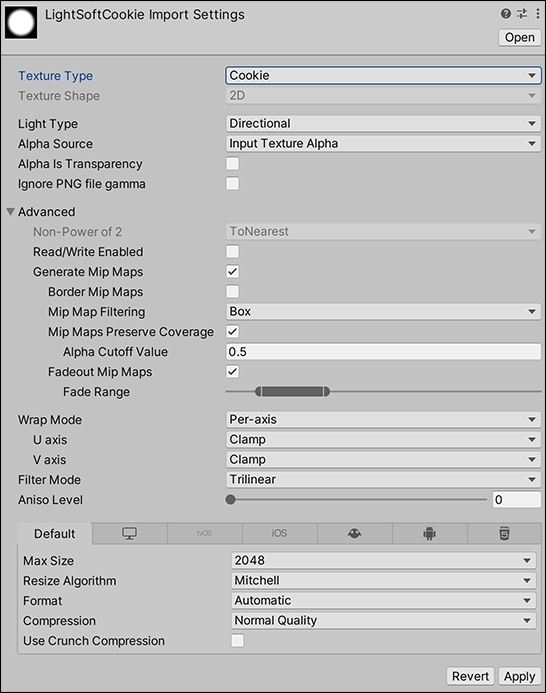
When you choose the Cookie Texture type, you can set the following additional properties:
| Property: | Function: | |
|---|---|---|
| Light Type | Define the type of Light that the cookie is applied to. Note that you must create your source texture with an appropriate layout: cookies for Point Lights must be laid out as cubemaps, and cookies for Directional Lights and Spot Lights must be laid out as regular 2D Textures. If you apply a cookie to a Directional Light, you can use a cookie configured for a Directional Light, or a cookie configured for a Spot Light. A Directional Light using a cookie configured for a Directional Light repeats the cookie in a tiled pattern all over the scene. A Directional Light using a cookie configured for a Spot Light projects the cookie just once in the direct path of the “beam” of the light. This is the only case where the position of a Directional Light is important. |
|
| Spotlight | With this type of Light, you want the edges of your Cookie Texture to be solid black to get the proper effect, so Unity sets the Wrap Mode to Clamp by default. | |
| Directional | With this type of Light, this Texture tiles, so Unity sets the Wrap Mode to Repeat by default. | |
| Point | When you choose this type of Light, you can also customize the Cube shape-specific | |
| Alpha Source | Specify how the alpha channel of the Texture is generated. More info. | |
| Alpha is Transparency | Enable this property to dilate the color and avoid filtering artifacts on the edges if the alpha channel you specify is Transparency. More info. | |
| Remove Matte (PSD) | Enable special processing for Photoshop files that use transparency (blending color pixels with white). More info | |
| Ignore PNG file gamma | Enable this property to ignore the Gamma attribute in PNG files. More info. | |
| Non Power of 2 | If the Texture has a non-power of two (NPOT) dimension size, this defines a scaling behavior at import time. More info. | |
| Read/Write Enabled | Enable this to access the Texture data from scripts using Texture2D.SetPixels, Texture2D.GetPixels and other Texture2D methods. More info. | |
| Generate Mip Maps | Check this box to enable mipmap generation. More info. This property does not change when switching to the Cookie Texture type. |
|
| Wrap Mode | Select how the Texture behaves when tiled. More info. | |
| Filter Mode | Select how the Texture is filtered when it gets stretched by 3D transformations. More info. | |
| Aniso Level | Increases Texture quality when viewing the Texture at a steep angle. More info. | |
In addition, you can use the Platform-specific overrides panel to set default options and their overrides for a specific platforms.
Lightmap
Select Lightmap if you are using the Texture as a Lightmap. This option enables encoding into a specific format (RGBM or dLDR, depending on the platform) and a post-processing step on Texture data (a push-pull dilation pass). With this Texture type, the Texture Shape property is always set to 2D for this Texture Type. For more information, see the documentation on Texture Shapes.
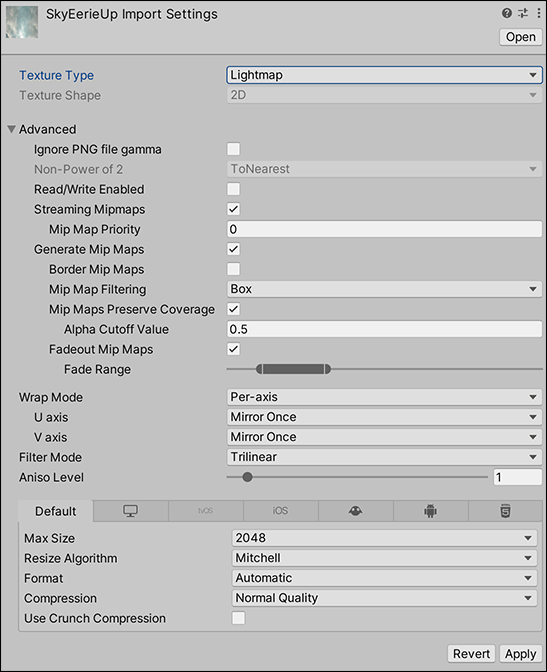
When you choose the Lightmap Texture type, you can set the following additional properties:
| Property: | Function: |
|---|---|
| Ignore PNG file gamma | Enable this property to ignore the Gamma attribute in PNG files. More info. |
| Non Power of 2 | If the Texture has a non-power of two (NPOT) dimension size, this defines a scaling behavior at import time. More info. |
| Read/Write Enabled | Enable this to access the Texture data from scripts using Texture2D.SetPixels, Texture2D.GetPixels and other Texture2D methods. More info. |
| Streaming Mip Maps | Enable this checkbox to use Mip Map Streaming on this Texture. More info. |
| Generate Mip Maps | Check this box to enable mipmap generation. More info. This property does not change when switching to the Lightmap Texture type. |
| Wrap Mode | Select how the Texture behaves when tiled. More info. |
| Filter Mode | Select how the Texture is filtered when it gets stretched by 3D transformations. More info. |
| Aniso Level | Increases Texture quality when viewing the Texture at a steep angle. More info. |
In addition, you can use the Platform-specific overrides panel to set default options and their overrides for a specific platforms.
Single Channel
Select Single Channel if you only need one channel in the Texture. With this Texture type, you can also change the Texture Shape property to define the Texture Shape.

When you choose the Single Channel Texture type, you can set the following additional properties:
| Property: | Function: | |
|---|---|---|
| Channel | Specify whether you want Unity to treat the Texture as an Alpha or Red channel. | |
| Alpha | Use the alpha channel. This setting does not allow compression. | |
| Red | Use the red color component. | |
| Alpha Source | Specify how the alpha channel of the Texture is generated. More info. | |
| Alpha is Transparency | Enable this property to dilate the color and avoid filtering artifacts on the edges if the alpha channel you specify is Transparency. More info. | |
| Remove Matte (PSD) | Enable special processing for Photoshop files that use transparency (blending color pixels with white). More info | |
| Ignore PNG file gamma | Enable this property to ignore the Gamma attribute in PNG files. More info. | |
| Non Power of 2 | If the Texture has a non-power of two (NPOT) dimension size, this defines a scaling behavior at import time. More info. | |
| Read/Write Enabled | Enable this to access the Texture data from scripts using Texture2D.SetPixels, Texture2D.GetPixels and other Texture2D methods. More info. | |
| Streaming Mip Maps | Enable this checkbox to use Mip Map Streaming on this Texture. More info. | |
| Generate Mip Maps | Check this box to enable mipmap generation. More info. This property does not change when switching to the Single Channel Texture type. |
|
| Wrap Mode | Select how the Texture behaves when tiled. More info. | |
| Filter Mode | Select how the Texture is filtered when it gets stretched by 3D transformations. More info. | |
| Aniso Level | Increases Texture quality when viewing the Texture at a steep angle. More info. | |
In addition, you can use the Platform-specific overrides panel to set default options and their overrides for a specific platforms.